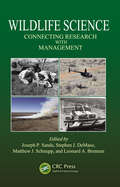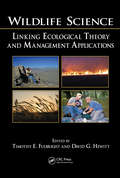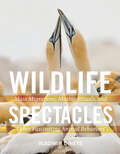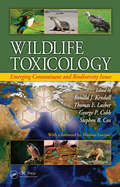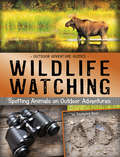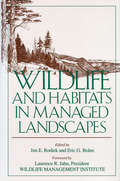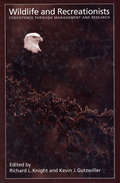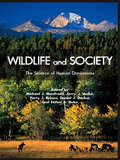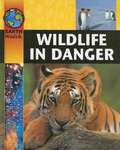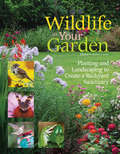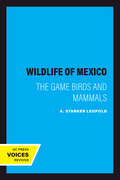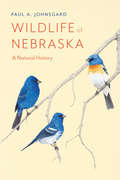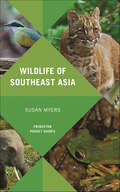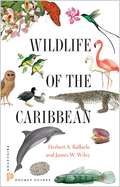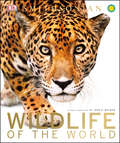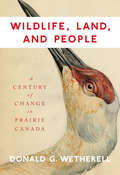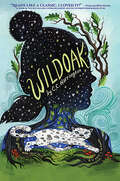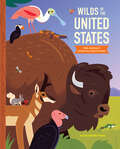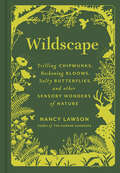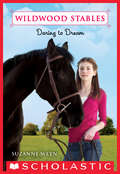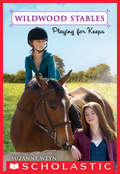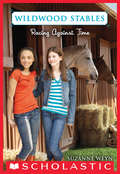- Table View
- List View
Wildlife Science: Connecting Research with Management
by Leonard A. Brennan Joseph P. Sands Stephen J. DeMaso Matthew J. SchnuppDespite the potential synergy that can result from basing management applications on results from research, there is a polarization of cultures between wildlife managers and wildlife researchers. Wildlife Science: Connecting Research with Management provides strategies for bridging cultural and communication gaps between these groups. The text covers the history of the longstanding disconnect, research and management entities, species case studies, management and policy case studies, and conclusions and future directions. The authors present case studies of both successful and failed interactions, providing a platform for discussion of the underlying issues. They examine current issues in wildlife science and management to explore real-world implications resulting from the research and management disconnect.
Wildlife Science: Linking Ecological Theory and Management Applications
by Timothy E. Fulbright and David G. HewittConsciously or not, wildlife managers generally act from a theoretical basis, although they may not be fully versed in the details or ramifications of that theory. In practice, the predictions of the practitioners sometimes prove more accurate than those of the theoreticians. Practitioners and theoreticians need to work together, but this proves di
Wildlife Spectacles: Mass Migrations, Mating Rituals, and Other Fascinating Animal Behaviors
by Vladimir DinetsEqual parts nature guide, adventure story, and coffee table book! People are captivated by wild animals—by their strength and their size and by the things they do to stay alive. In Wildlife Spectacles zoologist Vladimir Dinets dives deep into this wonder, allowing curious readers to discover just how spectacular wild animals can be. In the rich, fully illustrated pages you’ll discover the migration of gray whales along the Pacific coast, the dancing alligators of the Everglades, the synchronized blinking of fireflies near Tennessee, the swarms of feeding bats over the Mississippi River, the blue-glowing scorpions of the Southwest desert, hundreds of wintering tundra swans in New Jersey, and much more.
Wildlife Toxicology: Emerging Contaminant and Biodiversity Issues
by Ronald J. Kendall Stephen B. CoxUpdating the extremely successful Wildlife Toxicology and Population Modeling (CRC Press, 1994), Wildlife Toxicology: Emerging Contaminant and Biodiversity Issues brings together a distinguished group of international contributors, who provide a global assessment of a range of environmental stressors, including pesticides, environmental contaminant
Wildlife Watching: Spotting Animals on Outdoor Adventures (Outdoor Adventure Guides)
by Raymond BeanBinoculars, camera, action! This handy guidebook provides basic tips and tricks for wildlife spotting and nature photography, including recognizing animal signs, essential gear, and wildlife dos and don'ts. With bold photos and infographics, step-by-step projects, and expert instructions, OUTDOOR ADVENTURE GUIDES will have first-time campers and enthusiasts alike opting outside.
Wildlife and Habitats in Managed Landscapes
by Eric Bolen Jon RodiekAmericans are having an increasing impact on the rural landscape as development further encroaches in former wilderness areas. This disruptive land use is causing a decline in wildlife and wildlife habitats. Wildlife and Habitats in Managed Landscapes presents a new strategy for solving this problem by redefining habitats to include the concept of landscape. Employing this strategy, natural resource managers apply tools of planning, management, and design to entire landscapes to meet the needs of both wildlife and humans.
Wildlife and Recreationists: Coexistence Through Management And Research
by Joanna Burger Daniel J. Decker Richard L. Knight Kevin Gutzwiller H. Ken Cordell Paul KerlingerWildlife and Recreationists defines and clarifies the issues surrounding the conflict between outdoor recreation and the health and well-being of wildlife and ecosystems. Contributors to the volume consider both direct and indirect effects of widlife-recreationist interactions, including: *wildlife responses to disturbance, and the origins of these responses *how specific recreational activities affect diverse types of wildlife *the human dimensions of managing recreationists *the economic importance of outdoor recreation *how wildlife and recreationists might be able to coexist The book is a useful synthesis of what is known concerning wildlife and recreation. More important, it addresses both research needs and management options to minimize conflicts.
Wildlife and Society: The Science of Human Dimensions
by Daniel J. Decker Michael J. Manfredo Esther A. Duke Perry J. Brown Jerry J. VaskeWinner of The Wildlife Society's 2009 Wildlife Publication Award for outstanding edited book As human populations around the world continue to expand, reconciling nature conservation with human needs and aspirations is imperative. The emergence in recent decades of the academic field of human dimensions of fish and wildlife management is a proactive response to this complex problem. Wildlife and Society brings together leading researchers in the range of specialties that are relevant to the study of human dimensions of fish and wildlife work around the globe to provide theoretical and historical context as well as a demonstration of tools, methodologies, and idea-sharing for practical implementation and integration of practices. Chapters document the progress on key issues and offer a multifaceted presentation of this truly interdisciplinary field. The book * presents an overview of the changing culture of fish and wildlife management; * considers social factors creating change in fish and wildlife conservation; * explores how to build the social component into the philosophy of wildlife management; * discusses legal and institutional factors; * examines social perspectives on contemporary fish and wildlife management issues. Wildlife and Society is uniquely comprehensive in its approach to presenting the past, present, and future of human dimensions of fish and wildlife research and application. It offers perspectives from a wide variety of academic disciplines as well as presenting the views of practitioners from the United States, Europe, Africa, and Latin America. It is an important new reference for anyone concerned with fish and wildlife management or environmental conservation and protection.
Wildlife in Danger (Earth Watch)
by Sally MorganEARTH watch is an introduction to the environment. The series looks at the science of the world around us, how it is changing, and what we can do to keep the balance of nature. The straightforward text is complemented with clear photographs, explanatory diagrams, and information and action panels.
Wildlife in Your Garden: Planting and Landscaping to Create a Backyard Sanctuary
by Karen LanierImagine a thriving garden in your backyard, bursting with vibrantly colored blooms and lush green leaves, shaded by tall trees. Now imagine the same garden, alive with buzzing and flapping and chirping and croaking. Imagine the ecological impact of encouraging natural pollinators. Imagine the excitement of watching your garden become a hub of activity and learning about all of its different visitors. For those who relish observing nature in action, planning a garden to attract certain types of wildlife can bring daily enjoyment right into the backyard.Inside Wildlife in Your Garden:How to deal with and even appreciate the insects in your gardenReptile and amphibian backyard visitors and how they can contribute to a healthy ecosystem"Birdscaping"-planning and planting with birds in mindA special section on hummingbirds that includes an illustrated guide to twelve common typesUsing binoculars and field guides to identify birds by sight and by callsDifferent types of pollination and the plants and food crops that depend on itButterfly metamorphosis and gardening for the different life stagesHow bats and moths take over pollination duties at nightLearning to coexist with four-legged furry friends who like to dig and forageNatural ways to protect your garden from pests and discourage harmful wildlife
Wildlife in the City (Fountas & Pinnell LLI Gold #Level O)
by Claire GoldingWildlife in the City Author: Claire Golding
Wildlife of Mexico: The Game Birds and Mammals
by A. Starker LeopoldThis title is part of UC Press's Voices Revived program, which commemorates University of California Press’s mission to seek out and cultivate the brightest minds and give them voice, reach, and impact. Drawing on a backlist dating to 1893, Voices Revived makes high-quality, peer-reviewed scholarship accessible once again using print-on-demand technology. This title was originally published in 1959.
Wildlife of Nebraska: A Natural History
by Paul A. JohnsgardIn Wildlife of Nebraska: A Natural History, Paul A. Johnsgard surveys the variety and biology of more than six hundred Nebraska species. Narrative accounts describe the ecology and biology of the state&’s birds, its mammals, and its reptiles and amphibians, summarizing the abundance, distributions, and habitats of this wildlife. To provide an introduction to the state&’s major ecosystems, climate, and topography, Johnsgard examines major public-access natural areas, including national monuments, wildlife refuges and grasslands, state parks and wildlife management areas, and nature preserves. Including more than thirty-five line drawings by the author along with physiographic, ecological, and historical maps, Wildlife of Nebraska is an essential guide to the wildlife of the Cornhusker State.
Wildlife of Southeast Asia (Princeton Pocket Guides)
by Susan MyersThis handy photographic guide offers a stunning look at the wildlife of Southeast Asia, which includes Burma, Thailand, Laos, Cambodia, Vietnam, West Malaysia, and Singapore. Accessible text and more than 500 color photographs help readers to learn about and identify the most common species found in the region, particularly the mammals, birds, reptiles, amphibians, and insects that visitors will most likely encounter. Detailed photos are accompanied on facing pages by succinct species accounts highlighting key identification features, status, and distribution. The book's brief introduction offers readers useful information on major wildlife sites as well as practical advice on making the most of a wildlife-watching trip.Wildlife of Southeast Asia is the essential resource for visitors and residents interested in the fauna of this fascinating area of the world.A photographic guide to the wildlife of Southeast Asia, including Burma, Thailand, Laos, Cambodia, Vietnam, West Malaysia, and SingaporeMore than 500 stunning color photographsAccessible species accounts highlight key identification features, status, and distributionA brief introduction discusses wildlife locations and practical travel know-how
Wildlife of the Caribbean (Princeton Pocket Guides)
by James Wiley Herbert RaffaeleThis is the first comprehensive illustrated guide to the natural world of the Caribbean islands. It contains 600 vivid color images featuring 451 species of plants, birds, mammals, fish, seashells, and much more. While the guide primarily looks at the most conspicuous and widespread species among the islands, it also includes rarely seen creatures―such as the Rhinoceros Iguana and Cuban Solenodon―giving readers a special sense of the region's diverse wildlife. <p><p> Each species is represented by one or more color photos or illustrations; details regarding its identification, status, and distribution; and interesting aspects of its life history or relationship to humans. In addition, an introductory section focuses on the unique characteristics of the Caribbean’s fauna and flora, the threats faced by both, and some of the steps being taken to sustain the area’s extraordinary natural heritage.
Wildlife of the World (DK Wonders of the World)
by DKExperience the full force of nature with this stunning visual encyclopedia celebrating the world&’s most wonderful wildlife. With an inspiring foreword by leading naturalist and wildlife photographer Chris Packham, this epic adventure takes you across the continents to meet all creatures big and small. You&’ll visit the deserts of Australia, the grasslands of Africa, the rainforests of South America, the mountains of Asia, and the coral reefs of Australia on this mind-blowing tour to meet the incredibly diverse range of life on Earth. Breathtaking photography, animal profiles, accessible maps, and facts and stats combine to create this standout reference title. Revealing a wealth of species across hundreds of spectacular pages, Wildlife of the World introduces you to animals that roam, swim, and fly in each and every part of our planet.Calling all globe-trotters, nature enthusiasts, and biology students, this is your chance to experience the animal kingdom as never before and gain an absolutely essential addition to your home library.Produced in association with the Smithsonian Institution.
Wildlife, Land, and People: A Century of Change in Prairie Canada
by Donald WetherellEncounters with wild animals are among the most significant relationships between humans and the natural world. Presenting a history of human interactions with wildlife in Alberta, Manitoba, and Saskatchewan between 1870 and 1960, Wildlife, Land, and People examines the confrontations that led to diverse consequences - from the near annihilation of some species to the extraordinary preservation of others - and skilfully finds the roots of these relationships in people's needs for food, sport, security, economic development, personal fulfillment, and identity. Donald Wetherell shows how utilitarian practices, in which humans viewed animals either as friendly sources of profit or as threats to their economic and personal security, dominated until the 1960s. Alongside these views, however, other attitudes asserted that wild animals were part of the beauty, mystery, and order of the natural world. Wetherell outlines the ways in which this attitude gained strength after World War II, distinguished by a growing conviction that every species has ecological value. Through a century in which the natural landscape of the prairie region was radically transformed by human activity, conflicts developed over fur and game management, over Aboriginal use of the land, and over the preservation of endangered species like bison and elk. Yet the period also saw the creation of national parks, zoos, and natural history societies. Drawing on a wide array of historical sources and photographs as well as current approaches to environmental history, Wildlife, Land, and People enriches our understanding of the many-layered relationships between humans and nature.
Wildlife, Land, and People: A Century of Change in Prairie Canada (Carleton Library Series #197)
by Donald G. WetherellEncounters with wild animals are among the most significant relationships between humans and the natural world. Presenting a history of human interactions with wildlife in Alberta, Manitoba, and Saskatchewan between 1870 and 1960, Wildlife, Land, and People examines the confrontations that led to diverse consequences – from the near annihilation of some species to the extraordinary preservation of others – and skilfully finds the roots of these relationships in people’s needs for food, sport, security, economic development, personal fulfillment, and identity. Donald Wetherell shows how utilitarian practices, in which humans viewed animals either as friendly sources of profit or as threats to their economic and personal security, dominated until the 1960s. Alongside these views, however, other attitudes asserted that wild animals were part of the beauty, mystery, and order of the natural world. Wetherell outlines the ways in which this attitude gained strength after World War II, distinguished by a growing conviction that every species has ecological value. Through a century in which the natural landscape of the prairie region was radically transformed by human activity, conflicts developed over fur and game management, over Aboriginal use of the land, and over the preservation of endangered species like bison and elk. Yet the period also saw the creation of national parks, zoos, and natural history societies. Drawing on a wide array of historical sources and photographs as well as current approaches to environmental history, Wildlife, Land, and People enriches our understanding of the many-layered relationships between humans and nature.
Wildoak
by C. C. HarringtonGive the gift of connection this holiday season with this lushly illustrated story of a girl and a snow leopard and their unlikely friendship. <p><p>Maggie Stephens's stutter makes school especially hard. She will do almost anything to avoid speaking in class or calling attention to herself. So when her unsympathetic father threatens to send her away for so-called "treatment," she reluctantly agrees to her mother's intervention plan: a few weeks in the fresh air of Wildoak Forest, visiting a grandfather she hardly knows. It is there, in an extraordinary twist of fate, that she encounters an abandoned snow leopard cub, an exotic gift to a wealthy Londoner that proved too wild to domesticate. But once the cub's presence is discovered by others, danger follows, and Maggie soon realizes that time is running out, not only for the leopard, but for herself and the forest as well. <p><p>Told in alternating voices, Wildoak shimmers with beauty, compassion, and unforgettable storytelling as it explores the delicate interconnectedness of the human, animal, and natural worlds.
Wilds of the United States: The Animals' Survival Field Guide
by Alexander VidalThe definitive guide to the wildlife of the United States.Do you know which animal evades rattlesnakes by dancing?Or that some squirrels can glide on the air for hundreds of feet?Or that alligators can create their own year-round pools?Put on your best pair of hiking boots, grab a sturdy walking stick, and explore the wild places of the United States with this stunning guidebook! Soak up new and shocking facts about this unexpected world of ours; pore over captivating, detail-rich illustrations; and discover surprising new creatures (some may be closer than you think!) every time you open the book. From glistening, snow-packed mountain ranges to searing deserts, this immersive and accessible guide is a one-stop shop for outdoor adventurers, animal enthusiasts, inquisitive minds—and anyone who listens to the call of the wild.WILD CREATURES OF THE US: Alexander Vidal tells the story of the wild creatures of the United States, offering accessible and fun visual cues like flags and badges to identify particular features in a gamified, graphic, and eye-catching way.ONE NATION: Focusing on the individual characteristics of different regions that collectively make up the rich, diverse, and unique place that is the United States, readers will be excited to both find their own hometowns and explore the places they've haven't been . . . yet! This book is perfect for fans of The 50 States!OUR UNIQUE ENVIRONMENT: A great way to introduce conversations about the unique environment of the United States. Teachers and librarians will find this the perfect addition to their curricula!FAMILY TRAVEL: Perfect for any family embarking on summer or spring break travel into the great outdoors, this engaging guide will inspire young adventurers and serve as the ideal gift for readers passionate about our wild environment.GIFT BOOK: With lush illustration and a hefty, deluxe package, this is a fantastic gift for anyone who is passionate about the environment, animals, and traveling—regardless of age! It's also perfect for fans of oversize nonfiction like Maps and Animalium!Perfect for:• Nature enthusiasts• Science teachers and educators• Families who love road trips or national parks• Children who love animals• Anyone looking for artful gift books
Wildscape: Trilling Chipmunks, Beckoning Blooms, Salty Butterflies, and other Sensory Wonders of Nature
by Nancy LawsonFrom Nancy Lawson, author of The Humane Gardener, a first-of-its-kind guide that takes readers on an insightful and personal exploration of the secret lives of animals and plants.Master naturalist Nancy Lawson takes readers on a fascinating tour of the vibrant web of nature outside our back door—where animals and plants perceive and communicate using marvelous sensory abilities we are only beginning to understand. Organized into chapters investigating each of their five senses, Lawson's exploration reveals a remarkable world of interdependent creatures with amazing capabilitiesYou'll learn of ultrasound clicks humans can't hear, and ultraviolet colors humans can't see. You'll cross paths with foraging American bumblebees drawn to the scent of wild bergamot, urban sparrows who adapt their mating song in response to human clamor, trees that amp up their growth in response to deer and moose saliva, and a chipmunk behaving like the world's smallest pole vaulter to nab juicy red berries hanging from the lowest parts of a coral honeysuckle vine.Synthesizing cutting-edge scientific research, original interviews with animal and plant researchers, and poetic observations made in her own garden, Lawson shows us how to appreciate the natural environment from the sensory perspective of our wild neighbors right outside our door and beyond, and how to respect and nurture the habitats they need to survive.
Wildvogelhaltung
by Werner Lantermann Jörg AsmusKlimawandel, Waldrodungen, Tierhandel und Buschmeat-Jagd setzen auch den freilebenden Vogelbeständen in aller Welt immer mehr zu und haben bereits bei vielen Arten zum deutlichen Rückgang im Freiland geführt – manche sind mittlerweile stark gefährdet oder stehen kurz vor der Ausrottung. Ein Instrument, um bestimmte Arten zumindest in Menschenobhut zu erhalten, ist die gezielte Nachzucht. Dabei kann es jedoch nicht um die standardisierte „Ziervogelzucht“ gehen, wie sie seit Jahrzehnten von bestimmten Vereinen und Verbänden propagiert wird. Vielmehr geht es um eine professionelle Erhaltungszucht, wozu das vorliegende Buch die notwendigen Grundlagen liefert. Für solche Erhaltungszuchtprojekte müssen die noch in Menschenobhut vorhandenen Wildvogelbestände lokalisiert, zusammengeführt und in Zuchtbüchern gemanagt werden. Dazu bedarf es einer engen Zusammenarbeit von Tiergärtnern, Tiermedizinern, Genetikern, Museumsornithologen und auch privaten Praktikern. Insgesamt 33 solcher Fachleute aus mehreren Professionen konnten als Autoren für dieses Buch gewonnen werden und liefern im ersten Teil zunächst die theoretischen Grundlagen für gezielte Erhaltungszuchtprojekte. Im zweiten Teil werden alle in Menschenobhut haltungsrelevanten Wildvogelarten im Hinblick auf adäquate Haltungsformen, ihre Ernährungsansprüche sowie Zuchtmöglichkeiten und -probleme besprochen.
Wildwood Stables #1: Daring to Dream (Wildwood Stables #1)
by Suzanne WeynA rescued horse, an abandoned ranch, a new beginning for a very lucky girl ... and the start of an exciting new horse series! Taylor Henry loves horses, but her single mom can't afford riding lessons, much less a horse. So when she discovers an abandoned gelding and pony, Taylor is happy just to be around them. But the rescued animals have nowhere to go, and Taylor is running out of time to find them a good home. Could the empty old barn on Wildwood Lane be the answer? And could Taylor's wildest dream -- of a horse to call her own -- finally be coming true?
Wildwood Stables #2: Playing for Keeps (Wildwood Stables #2)
by Suzanne WeynNew friends, old rivalries, and the amazing place that brings them together ... welcome back to Wildwood Stables! Taylor Henry thinks Wildwood Stables is perfect -- even if it needs repair and a lot more money, it's become a home to her and her new horse, Prince Albert. And as soon as Taylor trains Prince Albert to give lessons, Wildwood will be in business! But the gelding refuses to let anyone ride him except Taylor. Can she convince Prince Albert to earn his keep? Or will Taylor need the help of her worst enemy to save her beloved new home?
Wildwood Stables #3: Racing Against Time (Wildwood Stables #3)
by Suzanne WeynA rescued horse, an abandoned ranch, a new beginning for a very lucky girl ... and the start of an exciting new middle-grade horse series, sure to be an instant classic! All of Taylor's hard work with Prince Albert is finally paying off, and both she and the horse feel at home at Wildwood Stables. But spoiled Plum Mason is still causing problems, overtraining her new horse, Shafir. Can Taylor and the other Wildwood girls protect Shafir from the reckless rider?
